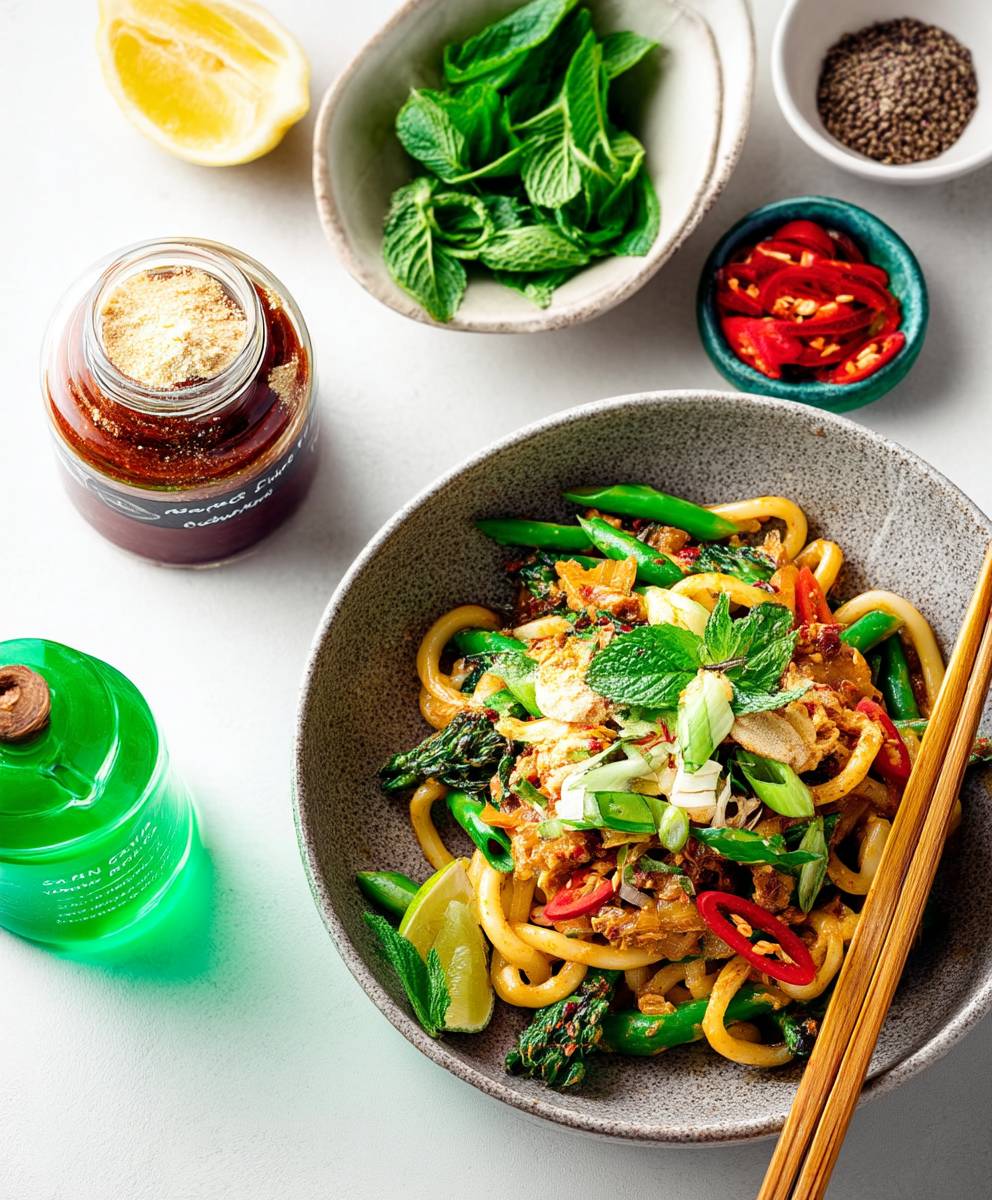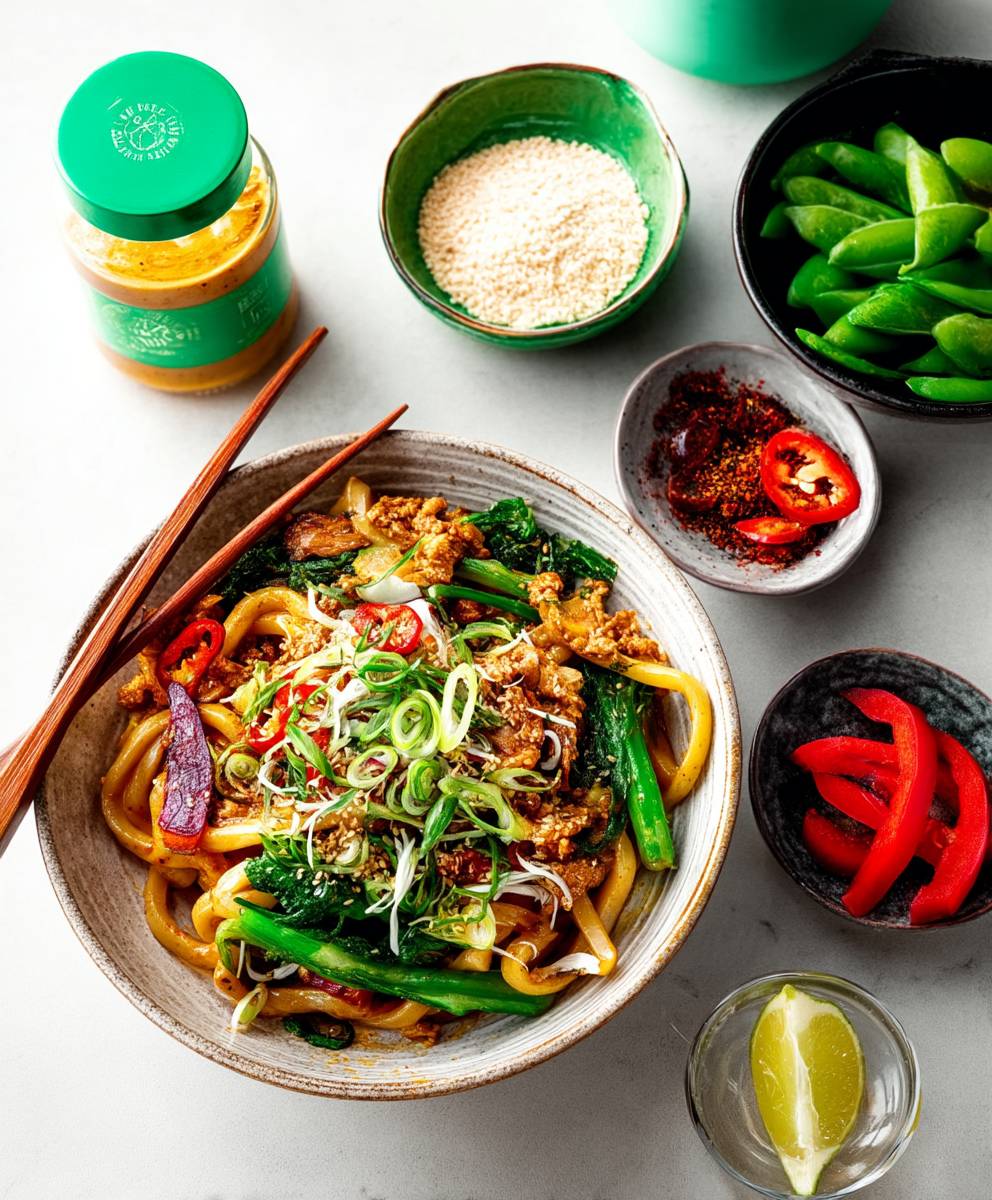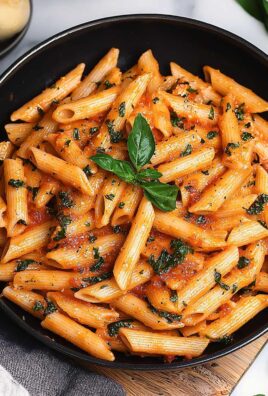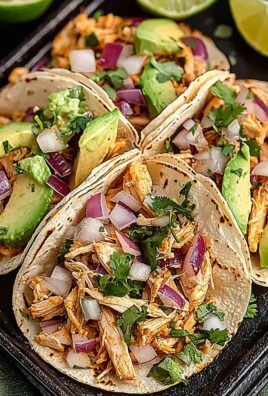Thai Curry Udon Noodles: Prepare to embark on a culinary adventure that will tantalize your taste buds and transport you straight to the vibrant streets of Thailand! Imagine thick, chewy udon noodles, slicked in a creamy, fragrant coconut curry sauce, bursting with the flavors of lemongrass, ginger, and chili. Are you drooling yet? I know I am just thinking about it!
While udon noodles themselves are a staple of Japanese cuisine, this dish beautifully marries them with the iconic flavors of Thai curry. Thai curries, with their rich history rooted in ancient spice trade routes, are renowned for their complex and harmonious blend of sweet, sour, salty, and spicy notes. This fusion creates a truly unique and unforgettable culinary experience.
What makes Thai Curry Udon Noodles so irresistible? It’s the perfect balance of textures the satisfying chewiness of the udon, the tender vegetables, and the smooth, velvety sauce. The aroma alone is enough to make your mouth water! Plus, it’s incredibly versatile. You can customize it with your favorite proteins and vegetables, making it a quick and easy weeknight meal that’s sure to please even the pickiest eaters. Whether you’re a seasoned Thai food enthusiast or a curious beginner, this recipe is a guaranteed crowd-pleaser.
Ingredients:
- For the Curry Paste:
- 2-3 dried red chilies, soaked in warm water for 30 minutes
- 1 stalk lemongrass, finely chopped
- 1 inch galangal, peeled and sliced
- 1 inch ginger, peeled and sliced
- 4 cloves garlic
- 1 small shallot, roughly chopped
- 1 teaspoon ground coriander
- 1/2 teaspoon ground cumin
- 1/4 teaspoon ground turmeric
- 1/4 teaspoon white peppercorns
- 1 tablespoon fish sauce (or soy sauce for vegetarian)
- 1 tablespoon lime juice
- 1 tablespoon vegetable oil
- For the Curry:
- 1 tablespoon vegetable oil
- 1 can (13.5 oz) coconut milk
- 1 cup vegetable broth (or chicken broth)
- 1 tablespoon fish sauce (or soy sauce for vegetarian)
- 1 tablespoon brown sugar (or palm sugar)
- 1 lime, juiced
- 1 red bell pepper, thinly sliced
- 1 yellow bell pepper, thinly sliced
- 1 cup sliced mushrooms (shiitake, oyster, or button)
- 1 cup snow peas, trimmed
- 1 cup broccoli florets
- 1/2 cup bamboo shoots, sliced
- 1 package (8-10 oz) pre-cooked udon noodles
- Optional: Protein of your choice (tofu, chicken, shrimp, etc.)
- For Garnish:
- Fresh cilantro leaves
- Chopped peanuts
- Lime wedges
- Red pepper flakes (optional)
- Green onions, thinly sliced
Making the Thai Curry Paste:
Okay, let’s start with the heart of our dish the curry paste! Don’t be intimidated; it’s easier than you think. Trust me, the homemade flavor is worth the little bit of effort.
- Soak the Chilies: First, drain the soaked dried red chilies. This softens them up and makes them easier to blend.
- Combine Ingredients: In a food processor or blender, combine the soaked chilies, lemongrass, galangal, ginger, garlic, shallot, ground coriander, ground cumin, ground turmeric, white peppercorns, fish sauce (or soy sauce), lime juice, and vegetable oil.
- Blend Until Smooth: Pulse the mixture until it forms a smooth paste. You might need to scrape down the sides of the food processor a few times to ensure everything is evenly blended. If it’s too thick, add a teaspoon or two of water to help it along. The consistency should be thick but spreadable.
- Taste and Adjust: Give the paste a taste! If you want it spicier, add another dried chili (soaked). If it needs more tang, add a squeeze of lime juice. Remember, you can always adjust the flavors to your liking.
Cooking the Thai Curry Udon Noodles:
Now for the fun part bringing everything together to create our delicious Thai Curry Udon Noodles! This is where the magic happens.
- Sauté the Curry Paste: Heat the vegetable oil in a large pot or wok over medium heat. Add the curry paste and sauté for 2-3 minutes, stirring constantly. This step is crucial because it blooms the spices and releases their fragrant oils. You’ll know it’s ready when the paste becomes very fragrant and slightly darker in color. Be careful not to burn it!
- Add Coconut Milk and Broth: Pour in the coconut milk and vegetable broth (or chicken broth). Stir well to combine the curry paste with the liquids. Bring the mixture to a simmer.
- Season the Curry: Add the fish sauce (or soy sauce) and brown sugar (or palm sugar). Stir until the sugar is dissolved. Taste the curry and adjust the seasoning as needed. You might want to add more fish sauce for saltiness, sugar for sweetness, or lime juice for acidity. Remember, balance is key!
- Add Vegetables: Add the sliced red bell pepper, yellow bell pepper, mushrooms, snow peas, broccoli florets, and bamboo shoots to the curry. If you’re using a protein like tofu, chicken, or shrimp, add it now as well. Cook for 5-7 minutes, or until the vegetables are tender-crisp and the protein is cooked through. Don’t overcook the vegetables; you want them to retain some of their crunch.
- Add Udon Noodles: Add the pre-cooked udon noodles to the curry. Gently toss to coat the noodles with the sauce. Cook for 2-3 minutes, or until the noodles are heated through. Be careful not to overcook the noodles, as they can become mushy.
- Finish with Lime Juice: Stir in the lime juice just before serving. This adds a bright, fresh flavor that really elevates the dish.
Serving and Garnishing:
Almost there! Now it’s time to plate up our masterpiece and add those final touches that make it truly special.
- Serve Immediately: Ladle the Thai Curry Udon Noodles into bowls.
- Garnish Generously: Garnish with fresh cilantro leaves, chopped peanuts, lime wedges, red pepper flakes (if desired), and thinly sliced green onions. Don’t be shy with the garnishes; they add flavor, texture, and visual appeal.
- Enjoy! Serve immediately and enjoy the explosion of flavors! This dish is best enjoyed hot.
Tips and Variations:
- Spice Level: Adjust the number of dried chilies in the curry paste to control the spice level. For a milder curry, use fewer chilies or remove the seeds. For a spicier curry, use more chilies or add a pinch of red pepper flakes.
- Vegetables: Feel free to substitute or add other vegetables to the curry, such as carrots, zucchini, eggplant, or spinach.
- Protein: This dish is delicious with tofu, chicken, shrimp, beef, or pork. You can also add hard-boiled eggs for extra protein.
- Coconut Milk: Use full-fat coconut milk for the richest flavor and creamiest texture. You can use light coconut milk, but the curry will be less rich.
- Noodles: If you can’t find udon noodles, you can substitute other types of noodles, such as rice noodles, egg noodles, or spaghetti.
- Make Ahead: The curry paste can be made ahead of time and stored in the refrigerator for up to a week. The curry itself can also be made ahead of time and reheated. However, it’s best to add the noodles just before serving to prevent them from becoming mushy.
- Vegetarian/Vegan Option: To make this dish vegetarian or vegan, substitute soy sauce for fish sauce and use vegetable broth instead of chicken broth. Ensure your curry paste uses vegetable oil and no animal products.
Storage Instructions:
Leftover Thai Curry Udon Noodles can be stored in an airtight container in the refrigerator for up to 3 days. Reheat gently on the stovetop or in the microwave. You may need to add a splash of water or broth to loosen the sauce.
Nutritional Information (Approximate):
Please note that the nutritional information is an estimate and may vary depending on the specific ingredients used.
- Calories: 500-600 per serving
- Fat: 25-35g
- Saturated Fat: 15-20g
- Cholesterol: 50-100mg (depending on protein)
- Sodium: 800-1200mg
- Carbohydrates: 50-70g
- Fiber: 5-10g
- Sugar: 10-15g
- Protein: 20-30g (depending on protein)

Conclusion:
So, there you have it! This Thai Curry Udon Noodles recipe is truly a flavor explosion you won’t want to miss. From the creamy coconut milk base to the vibrant vegetables and the satisfying chew of the udon noodles, every bite is a delightful experience. It’s quick enough for a weeknight dinner, yet impressive enough to serve to guests. I promise, once you try it, it’ll become a regular in your rotation.
But why is this recipe a must-try? Well, beyond the incredible taste, it’s incredibly versatile. You can easily adapt it to your dietary needs and preferences. Vegetarian? Simply omit the shrimp or chicken and add extra tofu or vegetables. Need a gluten-free option? Use gluten-free rice noodles instead of udon. Want to kick up the heat? Add an extra chili or two! The possibilities are endless.
Serving Suggestions and Variations:
Here are a few ideas to get you started:
- Garnish with Fresh Herbs: A sprinkle of fresh cilantro, Thai basil, or mint adds a burst of freshness and aroma.
- Add a Squeeze of Lime: A little lime juice brightens up the flavors and adds a touch of acidity.
- Top with Crushed Peanuts: For a satisfying crunch and nutty flavor, sprinkle some crushed peanuts on top.
- Serve with a Side of Spring Rolls: Make it a complete meal by serving your noodles with crispy spring rolls.
- Spice it Up: Add a dollop of sriracha or chili garlic sauce for an extra kick.
- Protein Power: Try adding grilled chicken, tofu, or even crispy fried fish for a heartier meal.
- Veggie Variety: Feel free to swap out the vegetables for your favorites. Bell peppers, broccoli, snap peas, or even mushrooms would all be delicious additions.
I personally love to add a fried egg on top for extra richness and protein. The runny yolk mixes with the creamy sauce and creates an unbelievably delicious combination. Trust me, you have to try it!
This Thai Curry Udon Noodles recipe is more than just a meal; it’s an adventure for your taste buds. It’s a chance to explore the vibrant flavors of Thai cuisine in a comforting and satisfying way. It’s also a fantastic way to use up leftover vegetables and customize a dish to your liking. I’ve made this recipe countless times, and I’m always amazed at how easy and delicious it is.
So, what are you waiting for? Grab your ingredients, put on some music, and get cooking! I’m confident that you’ll love this recipe as much as I do. And don’t be afraid to experiment and make it your own. That’s the beauty of cooking, after all!
I’m so excited for you to try this recipe! Once you do, please come back and share your experience in the comments below. Let me know what variations you tried, what you loved, and what you would change. I’m always looking for new ideas and inspiration, and I love hearing from my readers. Happy cooking!
Thai Curry Udon Noodles: A Flavorful & Easy Recipe
Fragrant Thai Curry Udon Noodles with homemade curry paste, tender vegetables, and chewy udon. Customizable and satisfying!
Ingredients
- 2-3 dried red chilies, soaked in warm water for 30 minutes
- 1 stalk lemongrass, finely chopped
- 1 inch galangal, peeled and sliced
- 1 inch ginger, peeled and sliced
- 4 cloves garlic
- 1 small shallot, roughly chopped
- 1 teaspoon ground coriander
- 1/2 teaspoon ground cumin
- 1/4 teaspoon ground turmeric
- 1/4 teaspoon white peppercorns
- 1 tablespoon fish sauce (or soy sauce for vegetarian)
- 1 tablespoon lime juice
- 1 tablespoon vegetable oil
- 1 tablespoon vegetable oil
- 1 can (13.5 oz) coconut milk
- 1 cup vegetable broth (or chicken broth)
- 1 tablespoon fish sauce (or soy sauce for vegetarian)
- 1 tablespoon brown sugar (or palm sugar)
- 1 lime, juiced
- 1 red bell pepper, thinly sliced
- 1 yellow bell pepper, thinly sliced
- 1 cup sliced mushrooms (shiitake, oyster, or button)
- 1 cup snow peas, trimmed
- 1 cup broccoli florets
- 1/2 cup bamboo shoots, sliced
- 1 package (8-10 oz) pre-cooked udon noodles
- Optional: Protein of your choice (tofu, chicken, shrimp, etc.)
- Fresh cilantro leaves
- Chopped peanuts
- Lime wedges
- Red pepper flakes (optional)
- Green onions, thinly sliced
Instructions
- Make the Curry Paste: Drain the soaked dried red chilies. In a food processor or blender, combine the soaked chilies, lemongrass, galangal, ginger, garlic, shallot, ground coriander, ground cumin, ground turmeric, white peppercorns, fish sauce (or soy sauce), lime juice, and vegetable oil. Pulse until smooth, scraping down the sides as needed. Add a teaspoon or two of water if needed. Taste and adjust seasonings.
- Sauté the Curry Paste: Heat 1 tablespoon of vegetable oil in a large pot or wok over medium heat. Add the curry paste and sauté for 2-3 minutes, stirring constantly, until fragrant and slightly darker.
- Add Liquids: Pour in the coconut milk and vegetable broth (or chicken broth). Stir well to combine. Bring to a simmer.
- Season the Curry: Add the fish sauce (or soy sauce) and brown sugar (or palm sugar). Stir until dissolved. Taste and adjust seasoning as needed.
- Add Vegetables (and Protein): Add the sliced red bell pepper, yellow bell pepper, mushrooms, snow peas, broccoli florets, and bamboo shoots to the curry. If using protein, add it now. Cook for 5-7 minutes, or until vegetables are tender-crisp and protein is cooked through.
- Add Udon Noodles: Add the pre-cooked udon noodles to the curry. Gently toss to coat. Cook for 2-3 minutes, or until heated through.
- Finish: Stir in the lime juice just before serving.
- Serve: Ladle into bowls and garnish with fresh cilantro leaves, chopped peanuts, lime wedges, red pepper flakes (if desired), and thinly sliced green onions. Serve immediately.
Notes
- Spice Level: Adjust the number of dried chilies in the curry paste to control the spice level. For a milder curry, use fewer chilies or remove the seeds. For a spicier curry, use more chilies or add a pinch of red pepper flakes.
- Vegetables: Feel free to substitute or add other vegetables to the curry, such as carrots, zucchini, eggplant, or spinach.
- Protein: This dish is delicious with tofu, chicken, shrimp, beef, or pork. You can also add hard-boiled eggs for extra protein.
- Coconut Milk: Use full-fat coconut milk for the richest flavor and creamiest texture. You can use light coconut milk, but the curry will be less rich.
- Noodles: If you can’t find udon noodles, you can substitute other types of noodles, such as rice noodles, egg noodles, or spaghetti.
- Make Ahead: The curry paste can be made ahead of time and stored in the refrigerator for up to a week. The curry itself can also be made ahead of time and reheated. However, it’s best to add the noodles just before serving to prevent them from becoming mushy.
- Vegetarian/Vegan Option: To make this dish vegetarian or vegan, substitute soy sauce for fish sauce and use vegetable broth instead of chicken broth. Ensure your curry paste uses vegetable oil and no animal products.
- Storage Instructions: Leftover Thai Curry Udon Noodles can be stored in an airtight container in the refrigerator for up to 3 days. Reheat gently on the stovetop or in the microwave. You may need to add a splash of water or broth to loosen the sauce.






Leave a Comment